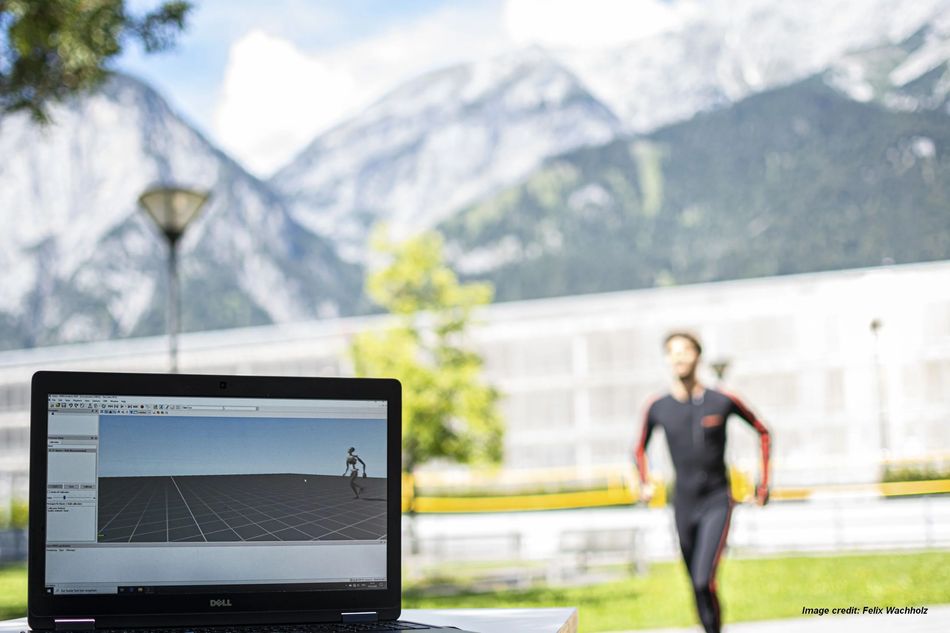Reliability Of Xsens Link For Running Kinematics: A Study By University Of Innsbruck
with Xsens Link
This article was first published on
www.movella.comThe ability to analyze human movement in real-world settings, beyond the confines of laboratory environments, is becoming increasingly important. Researchers in various disciplines, particularly sports science and biomechanics, are constantly seeking ways to bridge the gap between controlled lab settings and the complexities of movement in the field. This is where IMU (inertial measurement unit) sensor technology comes into play. Xsens Link, a popular motion capture system that utilizes wearable IMUs, is a valuable tool in this regard. Unlike traditional marker-based systems that restrict movement to lab environments, Xsens Link empowers researchers to capture movement in the field. This allows for a more holistic understanding of how athletes move during real-world activities, providing valuable insights for sports science and biomechanical research.
Understanding Running Kinematics and Inertial Motion Capture
Running is a fundamental human movement with countless variations depending on factors like speed, terrain, and individual biomechanics. Analyzing these variations is crucial for various applications. For instance, sports scientists can use kinematic data to evaluate running technique, identify potential injury risks, and optimize training programs. When it comes to analyzing running kinematics, IMU-based motion capture systems such as Xsens Link are gaining traction due to their portability, ease of use, and ability to capture movement in real-world settings. IMUs are small electronic devices containing accelerometers, gyroscopes, and magnetometers that can measure a wearer's acceleration, angular velocity, and magnetic field orientation. By strategically placing these sensors on different body segments Xsens Link can estimate the relative movement between segments and reconstruct 3D joint angles throughout a running motion.
Investigating the Reliability of Xsens Link for Running Kinematics
A recent study by Daniel Debertin, Anna Wargel and Maurice Mohr from the Department of Sport Science at the University of Innsbruck aimed to investigate the reliability of Xsens Link in estimating lower extremity joint angles during running. The study involved 17 recreational runners who completed running trials wearing Xsens Link suits on both asphalt and woodchip surfaces. The researchers assessed both within-day reliability (comparing runs on the same day) and between-day reliability (comparing runs on different days).
The findings of the study revealed valuable insights into the reliability of Xsens in the analysis of running kinematics.

Reliability: A Strength of Xsens Link and considerations for longitudinal studies
The study demonstrated good to excellent reliability for Xsens Link in estimating joint angles when comparing runs within the same day. This indicates that the system can effectively capture subtle adaptations in running technique that occur during a single running session. For instance, if a researcher wants to investigate how a runner adjusts their hip or knee flexion angles in response to a change in surface from asphalt to woodchip, Xsens Link would be a suitable tool. This ability to capture within-day adaptations highlights the potential of Xsens Link for various applications in sports science, such as:
- Evaluating the effectiveness of real-time feedback interventions: Trainers can provide runners with real-time feedback on their running form using data captured by Xsens Link. The within-day reliability allows researchers to assess how quickly and effectively runners adapt their form based on this feedback.
- Comparing the effects of different running drills: Researchers can use Xsens Link to compare the impact of various running drills on running mechanics. The ability to capture within-day adaptations ensures that any observed changes in joint angles are likely due to the specific drill and not random variations.
While Xsens Link can track changes in sagittal plane angles (flexion/extension) like hip, knee, and ankle angles over time for tracking angles over different days (longitudinal studies), the Xsens Link suit likely lacks reliability, particularly for frontal plane movements. Researchers focusing on frontal plane mechanics might need to consider alternative systems or combine Xsens Link with other technologies.
Surface Variations and Trail Running Applications
The researchers also discovered an interesting finding regarding surface variations. While the researchers expected some differences in reliability between running on asphalt and woodchip surfaces, they observed minimal impact. This suggests that Xsens Link can effectively capture reliable kinematic data even on uneven terrain. The researchers themselves expressed surprise at this result, highlighting the need for further investigation into the system's performance on various surfaces commonly encountered in trail running environments.
This finding opens doors for exciting possibilities in trail running research. Analyzing running mechanics on trails is crucial for understanding injury risks specific to uneven terrain and developing effective prevention strategies. Traditional marker-based systems are impractical for such settings due to their limited range. Xsens Link, with its portability and ability to capture reliable data on different surfaces, emerges as a valuable tool for researchers in this domain.
Future Advancements and Considerations
While Xsens Link offers significant advantages for real-world running analysis, the study also highlights areas for improvement. The researchers acknowledge limitations, particularly regarding the challenges with frontal plane joint angles (e.g., ankle eversion/inversion). However, they also suggest promising advancements that could address these limitations.
It is important to remember that optimal reliability hinges not only on the technology itself but also on careful sensor placement and calibration. Researchers using Xsens Link should ensure they follow the guidelines and established best practices for sensor placement to minimize errors and maximize data quality.
When choosing a system, researchers should consider reliability alongside validity (accuracy). Ultimately, the choice of motion capture system depends on the specific needs of the research project. Considering both reliability and validity ensures researchers can draw meaningful conclusions from their kinematic data. Xsens Link represents a significant advancement in wearable motion capture technology, enabling researchers to analyze running mechanics outside the confines of a laboratory. Understanding the system's strengths and limitations will allow researchers to leverage its capabilities to unlock valuable insights into running performance and injury prevention strategies.
